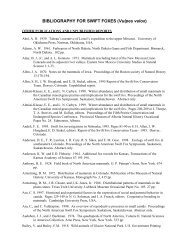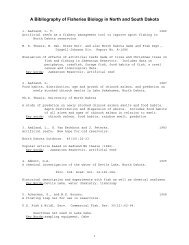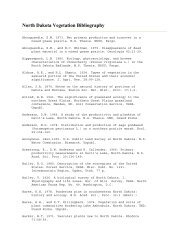PDF Download - Northern Prairie Wildlife Research Center
PDF Download - Northern Prairie Wildlife Research Center
PDF Download - Northern Prairie Wildlife Research Center
- No tags were found...
Create successful ePaper yourself
Turn your PDF publications into a flip-book with our unique Google optimized e-Paper software.
Sargeant, White, Sovada and Cypherwithout obtaining food they anticipated. Had we rewardedfoxes with food, we might have faced the opposite problem:visitation rates that increased with habituation.Seasonal variation in the attractiveness of food may furthercomplicate matters. Foxes in Wyoming always consumedmackerel baits when visiting stations in earlyspring, but not in summer when food was more abundant(Woolley et al. 1995). Effects of seasonal differences infood availability can be controlled via survey design, buteffects of annual differences cannot. Annual differences inattractiveness of food baits may therefore reduce the effectivenessof food-based lures for surveys of relative abundancebecause such lures may provoke different responseson different survey occasions.FAS is an obvious alternative to food-based lures.Swift and kit foxes, however, may avoid FAS because theyassociate it with coyotes or other canids (Orloff 1992,Hoagland 1995). Most evidence of differences in the performanceof lures is anecdotal, however, and reasonsgiven for hypothesized differences are speculative.Although coyotes were the principal source of kit fox mortalityon both our California study areas (Cypher andScrivner 1992, Standley et al. 1992), foxes visited stationsbaited with FAS at relatively high rates.Tracking MediaPrevious efforts to maximize visitation rates of swiftfoxes have focused on the use of various baits and lures(Allen et al. 1995, Luce and Lindzey 1996). Our results,however, suggest the choice of tracking medium may bemuch more important. Visitation rates to stations composedof natural materials were much higher than for trackplates. Although natural materials may require greater carein track identification, this disadvantage is outweighed bybenefits of higher detection rates. Moreover, mixing sandwith mineral oil greatly facilitated identification of swiftfox tracks in Kansas.ConclusionsResponses of carnivores to scent stations may varylocally. Our results nonetheless suggest contemporary perceptionsof scent-station techniques are frequently inaccurateand sometimes lead to inefficient survey designs. Wequestion the use of scent stations for surveys of distribution;acknowledge potential of the method for assessmentsof relative abundance; discourage autumn surveys; showthat repeated operation of stations can lead to habituationand reduce, rather than increase, precision of results;demonstrate a marked reduction in visitation rate resultingfrom wariness of swift foxes toward track plates; and prescribecautious extension of our results to different populations.For the most part, our insights were gained throughstudy of data collected for other purposes. We hope theyinspire controlled experimental comparisons of scent-stationsurvey techniques for swift and kit foxes. Given currentinterest in the precarious population status of thesesmallest North American canids and widespread use ofscent-station surveys, such comparisons seem overdue.AcknowledgmentsWe thank our cooperators for generously providing data thatmade this paper possible: Enterprise Advisory Services, Inc.; theUnited States Department of Energy; Chevron, U.S.A; EG&GEnergy Measurements, Inc.; the California Army National Guard,Camp Roberts, California; the Kansas Department of Fish,<strong>Wildlife</strong> and Parks; the North Dakota Game and Fish Department;and <strong>Northern</strong> <strong>Prairie</strong> <strong>Wildlife</strong> <strong>Research</strong> <strong>Center</strong>, United StatesGeological Survey. Special thanks are due to Bill Berry, JulieEliason, Michael Hanson, Greg Warrick, and Christiane Roy forassistance with data collection and processing.Literature CitedAllen, S.H., 1.W Hoagland, and E.D. Stukel, editors. 1995.Report of the swift fox conservation team. North Dakota Gameand Fish Department, Bismarck, North Dakota.Beltnin, 1.F., M. Delibes, and 1.R. Rau. 1991. Methods of censusingred fox (Vulpes vulpes) populations. Hystrix 3:199-214.Cypher, B.L., and 1. H. Scrivner. 1992. Coyote control to protectendangered San Joaquin kit foxes at the Naval PetroleumReserves, California. Pp. 42--47 in 1.E. Borrecco and R.E.Marsh, editors. Proceedings of the 15th Vertebrate PestConference. Newport Beach, California.Daniel, W W 1990. Applied nonparametric statistics. Secondedition. PWS-Kent, Boston, Massachusetts.Efron, B., and R.J. Tibshirani. 1993. An introduction to the bootstrap.Chapman and Hall, London, England.Fitzgerald, 1.P., and B. Roell. 1995. Preliminary results of ecologicalinvestigations of the swift fox (Vulpes velox) in northernWeld County, Colorado, October 1994-September 1995.Pp. 56-60 in S. H. Allen, 1. W Hoagland, and E. D. Stukel, editors.Report of the swift fox conservation team. North DakotaGame and Fish Department, Bismarck, North Dakota.Gese, E.M., and L.D. Mech. 1991. Dispersal of wolves (Canislupus) in northeastern Minnesota, 1969-1989. CanadianJournal of Zoology 69:2946-2955.Griffith, B., H.M. Wight, WS. Overton, and E.C. Meslow. 1981.Seasonal properties of the coyote scent station index. Pp. 197220 in F.L. Miller, A. Gunn, and S.R. Hieb, editors.Symposium on census and inventory methods for populationsand habitats. Forest, <strong>Wildlife</strong> and Range Experiment Station,University of Idaho, Moscow, Idaho. 1980 Symposium proceedings,Banff, Alberta.Harris, C.E. 1987. An assessment of techniques for monitoringSan Joaquin kit fox population abundance on Naval PetroleumReserve #1, Kern County, California. U.S. Department ofEnergy Topical Report Number EGG 10282-2159, EG&G/EMSanta Barbara Operations. National Technical InformationService, Springfield, Virginia.Harrison, D.J. 1992. Dispersal characteristics ofjuvenile coyotesin Maine. The Journal of <strong>Wildlife</strong> Management 56: 128-138.Hoagland, 1.W 1995. Distribution and ecology of swift fox inOklahoma. Pp. 33-38 in S. H. Allen, J.W Hoagland, and E.D.Stukel, editors. Report of the swift fox conservation team.North Dakota Game and Fish Department, Bismarck, NorthDakota.Kahn, R., and T. Beck. 1996. Swift fox investigations inColorado, 1996. Pp. 10-15 in B. Luce and F. Lindzey, editors.104Ecology and Conservation of Swift Foxes in a Changing World








